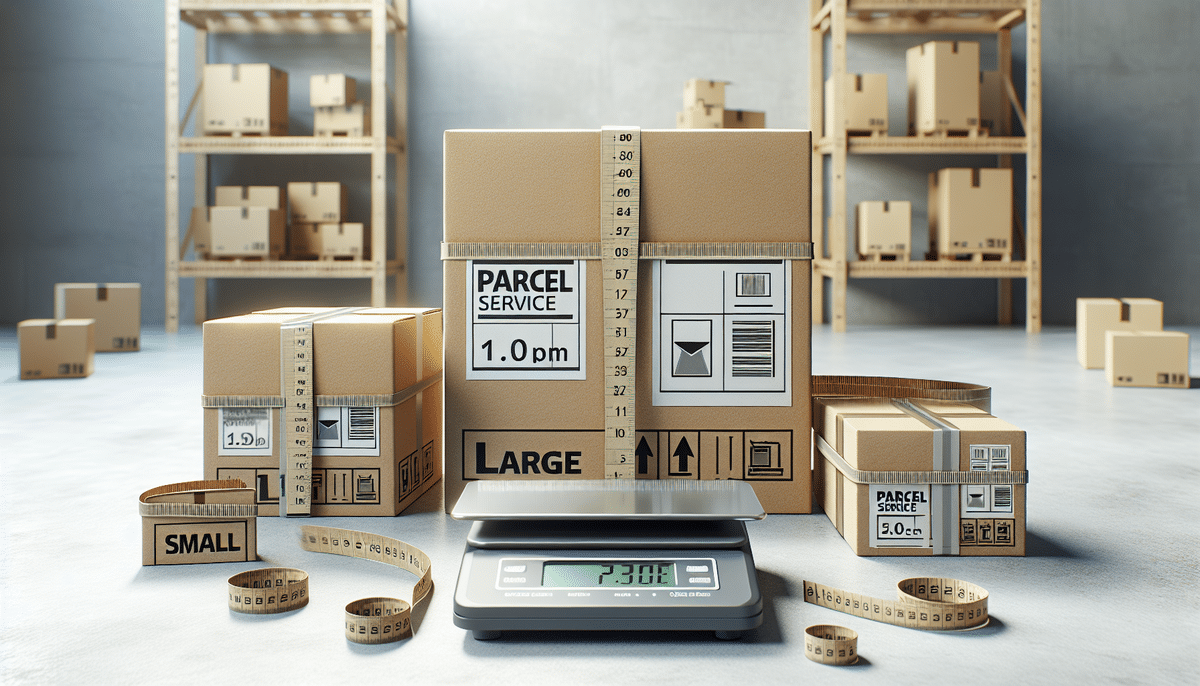Understanding UPS Shipping Rates Based on Package Size
When it comes to shipping packages, choosing the right carrier and understanding the costs involved can make all the difference. UPS is one of the major players in the shipping industry, offering a range of services to businesses and individuals alike. However, the size of your package can significantly impact your UPS shipping rates. In this article, we'll delve into why package size matters, how UPS calculates shipping costs, and how you can optimize your shipments to save money.
Why Package Size Matters When Shipping with UPS
When you send a package with UPS, you're not only paying for the weight of your items but also the space they occupy in the carrier's network. Larger packages may cost more to ship, even if they weigh the same as smaller items, due to UPS's "dimensional weight" pricing system. This system calculates the package's volume (length x width x height) and compares it to its actual weight. If a package is relatively light but takes up a lot of space, you'll be charged based on its dimensional weight.
Additionally, the size of your package can affect its safety during transit. Larger packages may be more challenging to handle and are more prone to damage if not packaged properly. This is especially true for fragile or delicate items. To ensure safe delivery, use appropriate packaging materials and clearly label your package with any necessary handling instructions.
The destination of your package is another crucial factor. Shipping to remote or hard-to-reach locations may incur additional fees or longer delivery times, as UPS may need to allocate specialized vehicles or equipment. It's advisable to check with UPS or your shipping provider for any additional fees or restrictions when shipping to your desired destination.
The Factors That Determine UPS Shipping Rates
UPS considers several factors when calculating the cost of your shipment, including:
- The origin and destination of your package
- The weight and dimensions of your package
- The shipping speed you choose (e.g., next-day, priority, standard)
- The service options you select (e.g., insurance, signature confirmation, Saturday delivery)
- The type of item you're shipping (e.g., hazardous materials, perishable goods)
Among these, package size and weight are particularly influential in determining UPS shipping rates. Understanding these variables can help you make informed decisions about your shipments, potentially saving you money.
Another significant factor affecting UPS shipping rates is the distance between the origin and destination. The farther your package travels, the higher the shipping cost is likely to be. Additionally, seasonal demand can impact rates, with peak seasons like holidays often resulting in higher prices due to increased shipping volumes. Planning your shipments with these factors in mind can help you manage and budget your shipping costs effectively.
How to Measure Package Size for Accurate UPS Shipping Costs
Accurately measuring your package is essential for determining the correct UPS shipping costs. Here's how to do it:
- Use a tape measure to determine the length, width, and height of your package.
- Round each measurement up to the nearest inch for accuracy.
- Multiply these dimensions together to calculate the package's volume in cubic inches.
- Divide the volume by UPS's dimensional weight divisor (typically 139 for ground shipments) to obtain the dimensional weight.
UPS will charge you based on either the actual weight or the dimensional weight of your package, whichever is greater. To avoid unexpected charges, ensure you measure your package accurately and choose the appropriate shipping option.
Additionally, consider the volume added by packaging materials like bubble wrap or packing peanuts. These materials can increase both the size and weight of your package, so include them in your measurements. For fragile items, use sturdy packaging to protect your items during transit.
The Difference Between Dimensional Weight and Actual Weight
Understanding the difference between dimensional weight and actual weight is crucial for optimizing your shipping costs. Actual weight refers to the physical weight of your item(s) as measured on a scale. Dimensional weight, however, reflects the amount of space your package occupies in the carrier's network.
Dimensional weight is calculated by multiplying the length, width, and height of your package and then dividing that number by a dimensional weight divisor. For UPS ground shipments, the divisor is typically 139, while other services may use different divisors. Always check the latest UPS guidelines to ensure accurate calculations.
How to Calculate Dimensional Weight for UPS Shipping
To calculate the dimensional weight of your package for UPS shipping, follow these steps:
- Measure the length, width, and height of your package in inches.
- Multiply these dimensions to get the volume in cubic inches.
- Divide the volume by UPS's dimensional weight divisor (e.g., 139 for ground shipments).
- Compare the dimensional weight to the actual weight of your package.
If the dimensional weight is greater than the actual weight, UPS will charge based on the dimensional weight. This emphasizes the importance of optimizing package size to minimize shipping costs.
Tips for Reducing UPS Shipping Costs Based on Package Size
Implementing the following strategies can help reduce your UPS shipping costs related to package size:
- Choose smaller boxes whenever possible to reduce both actual and dimensional weight.
- Remove excess packaging materials that add unnecessary size and weight.
- Disassemble items, if feasible, to minimize their overall volume.
- Consolidate multiple items into a single package to optimize space.
- Select a slower shipping speed when time allows, as this can be less expensive for larger packages.
By adopting these practices, you can decrease your dimensional weight and overall shipping expenses.
Understanding the Impact of Oversized Packages on UPS Shipping Rates
Packages that exceed certain size and weight thresholds are classified as "oversized" or "over maximum limit" items, often resulting in higher shipping costs. For instance, a package measuring more than 130 inches in length and girth combined may incur additional fees. UPS also imposes an "over maximum limit charge" for packages exceeding weight limits, such as 150 pounds for standard shipments.
If you frequently ship oversized packages, it's advisable to familiarize yourself with UPS's specific guidelines and pricing structures. This preparation can help you anticipate costs and choose the most cost-effective shipping methods.
How to Pack Your Items to Minimize Package Size and Save on UPS Shipping
Effective packing strategies can help reduce your package size and save on UPS shipping costs. Consider the following tips:
- Choose the right-sized box for your items to avoid unnecessary space.
- Wrap fragile items carefully to prevent breakage without adding excessive bulk.
- Use materials like bubble wrap or foam peanuts to cushion your items without significantly increasing package size.
- Disassemble items, if possible, to reduce their overall volume.
- Fill any empty space in the box with packing materials to prevent items from shifting during transit.
- Seal the box securely with quality packing tape to ensure durability during shipping.
By packing thoughtfully, you can decrease your package's size and weight, leading to lower shipping costs and ensuring your items arrive safely.
Comparing UPS Shipping Rates for Different Package Sizes and Weights
Determining the optimal size and weight for your package can be achieved by comparing UPS shipping rates across various scenarios. UPS provides a range of online tools to estimate shipping costs based on package size, weight, and other factors. Utilizing these tools can help you understand how different package dimensions and weights affect your shipping expenses.
Additionally, consider using third-party shipping calculators and consulting UPS's official rate calculator to get precise estimates tailored to your specific shipment needs.
The Importance of Choosing the Right Box for Your UPS Shipment
Selecting the appropriate box is essential for both the safety of your items and the cost-effectiveness of your shipment. Consider the following factors:
- Use a box that is sturdy and in good condition to protect your items during transit.
- Ensure the box is large enough to accommodate your items without excessive empty space, but not so large that it increases dimensional weight unnecessarily.
- Avoid using boxes with old shipping labels or pre-existing damage that could compromise the integrity of your shipment.
- Consider using UPS-provided boxes, which are designed to meet their shipping standards and may offer cost savings.
Choosing the right box can help minimize shipping costs by reducing both actual and dimensional weight, while also ensuring your items arrive intact.
How to Use UPS Online Tools to Estimate Shipping Costs Based on Package Size
UPS offers several online tools to help you estimate shipping costs based on your package's size and other factors:
- UPS Rate and Service Guide: Provides detailed information on shipping rates and available services.
- UPS Calculate Time and Cost Tool: Allows you to input package dimensions, weight, origin, and destination to estimate shipping costs.
- UPS My Choice: A platform that lets you manage your shipments, view real-time updates, and receive alerts about your package's status.
Utilizing these tools can give you a clearer understanding of your shipping costs and help you make informed decisions to optimize your shipments.
How Different Delivery Options Can Impact UPS Shipping Rates Based on Package Size
The delivery options you select can significantly influence your UPS shipping rates, especially concerning package size. For example:
- Shipping Speed: Choosing faster shipping options like next-day or 2-day delivery generally costs more than standard shipping.
- Additional Services: Adding services such as insurance or signature confirmation can increase your shipping costs but provide added security and peace of mind.
When selecting delivery options, weigh the benefits of faster delivery and additional services against their costs. Selecting the right combination of services can help you balance cost and service quality based on your specific needs.
Key Takeaways: Understanding and Optimizing Your UPS Shipping Rates Based on Package Size
Shipping items with UPS requires a clear understanding of how package size affects shipping rates. By accurately measuring your package, packing strategically, and leveraging UPS's online tools, you can optimize your shipments to save money. Consider factors such as dimensional weight, delivery options, and package size thresholds when planning your shipments. Staying informed and proactive in your shipping strategy can lead to significant cost savings and ensure the safe delivery of your items.








